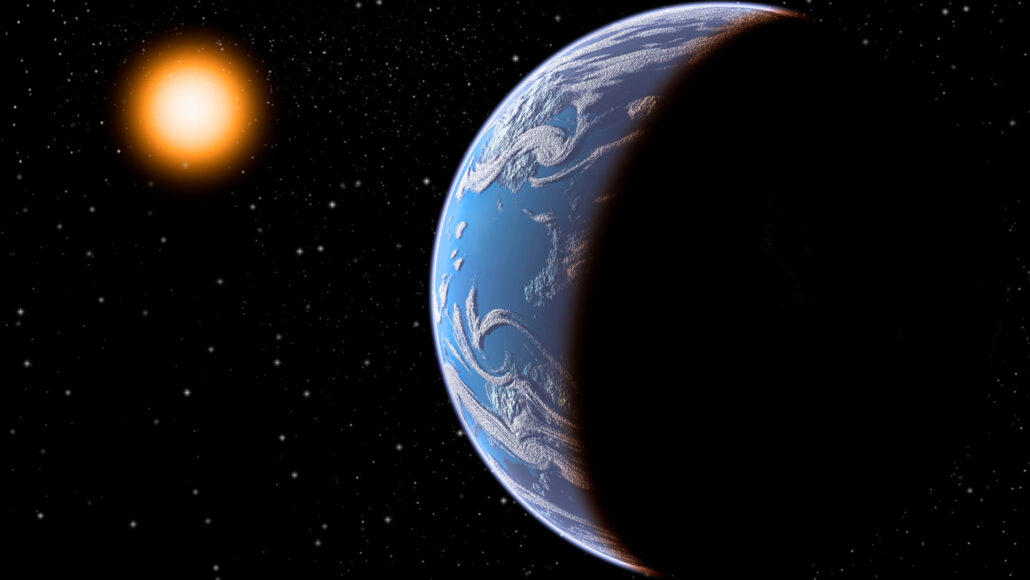alien: A non-native organism. (in astronomy) Life on or from a distant world.
atmosphere: The envelope of gases surrounding Earth, another planet or a moon.
boil: To heat a liquid to the temperature at which it turns to vapor.
Enceladus: The sixth largest of Saturn’s 82 known moons. Enceladus is bright white and covered with a thick shell of ice. Deep beneath that ice sits what appears to be a global ocean of salty liquid water. Enceladus is a round sphere, 500 kilometers (310 miles) across. It is a little less than one-third the width of Earth's moon.
Europa: One of the moons of Jupiter and the sixth-closest satellite to the planet. Europa, 1,951 miles across, has a network of dark lines on a bright, icy surface.
exotic: An adjective to describe something that is highly unusual, strange or foreign (such as exotic plants).
gas giant: A giant planet that is made mostly of helium and hydrogen, which on Earth are gases. Jupiter and Saturn are gas giants.
Goldilocks zone: A term that astronomers use for a region out from a star where conditions there might allow a planet to support life as we know it. This distance would be not too close to its sun (otherwise the extreme heat would evaporate liquids). It also can’t be too far (or the extreme cold would freeze any water). But if it’s just right — in that so-called Goldilocks zone — water could pool as a liquid and support life.
habitable: A place suitable for humans or other living things to comfortably dwell.
host: (v.) The act of providing a home or environment for something.
Jupiter: (in astronomy) The solar system’s largest planet, it has the shortest day length (9 hours, 55 minutes). A gas giant, its low density indicates that this planet is composed mostly of the light elements hydrogen and helium. This planet also releases more heat than it receives from the sun as gravity compresses its mass (and slowly shrinks the planet).
liquid: A material that flows freely but keeps a constant volume, like water or oil.
Mars: The fourth planet from the sun, just one planet out from Earth. Like Earth, it has seasons and moisture. But its diameter is only about half as big as Earth’s.
methane: A hydrocarbon with the chemical formula CH4 (meaning there are four hydrogen atoms bound to one carbon atom). It’s a natural constituent of what’s known as natural gas. It’s also emitted by decomposing plant material in wetlands and is belched out by cows and other ruminant livestock. From a climate perspective, methane is 20 times more potent than carbon dioxide is in trapping heat in Earth’s atmosphere, making it a very important greenhouse gas.
moon: The natural satellite of any planet.
planet: A large celestial object that orbits a star but unlike a star does not generate any visible light.
radiation: (in physics) One of the three major ways that energy is transferred. (The other two are conduction and convection.) In radiation, electromagnetic waves carry energy from one place to another. Unlike conduction and convection, which need material to help transfer the energy, radiation can transfer energy across empty space.
shell: The normally hard, protective outer covering of something.
solar: Having to do with the sun or the radiation it emits. It comes from sol, Latin for sun.
solar system: The eight major planets and their moons in orbit around our sun, together with smaller bodies in the form of dwarf planets, asteroids, meteoroids and comets.
star: The basic building block from which galaxies are made. Stars develop when gravity compacts clouds of gas. When they become hot enough, stars will emit light and sometimes other forms of electromagnetic radiation. The sun is our closest star.
sun: The star at the center of Earth’s solar system. It is about 27,000 light-years from the center of the Milky Way galaxy. Also a term for any sunlike star.
titan: The term for any gigantic being. The term comes from Greek mythology. The six sons and six daughters of the Greek gods Uranus and Gaea were known as titans. Capitalized Titan is a moon of Saturn.
ultraviolet: A portion of the light spectrum that is close to violet but invisible to the human eye.
X-ray: A type of radiation analogous to gamma rays, but having somewhat lower energy.









